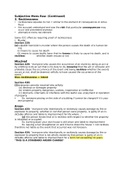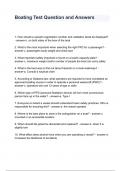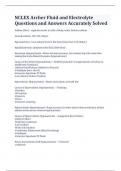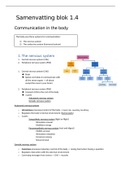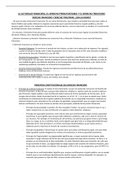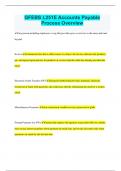Choice Questions
,Question 1 of 40
3.0 Points
The ombudsman appointed by the Health Professions Council
of South Africa must inter alia—
• A. Mediate in the case of minor transgressions referred to
him or her for mediation with a view to resolving such
matters.
Feedback: It is indeed one of the functions of the
ombudsman to mediate in the case of minor
transgressions referred to him or her for mediation
with a view to resolving such matters. Refer to section
3.8.3 of the study guide.
• B. Arbitrate in the case of minor transgressions
referred to him or her for arbitration with a view to
resolving such matters.
• C. Investigate all complaints of unprofessional
conduct by a registered medical practitioner.
• D. Peruse and analyze all complaints received,
categorizing them by significance and seriousness, and
record each complaint against the respondent’s name
as it appears in the register.
Question 2 of 40
3.0 Points
The most important judgment on indemnity clauses in hospital
admission forms is Afrox Healthcare Bpk v Strydom 2002 (6)
SA 21 (SCA). The Consumer Protection Act 68 of 2008 came
into effect after the Afrox case, altering the legal stance
somewhat.
Which one of the following statements is correct?
• A. It remains unnecessary for a hospital (service provider) to
highlight an indemnity clause in a hospital admission form to
the patient (consumer).
• B. Since the enactment of the Consumer Protection Act 68 of
2008, an indemnity clause in a hospital admission form is
always null, void, and unenforceable.
• C. Uncertainty persists regarding the validity and
enforceability of an indemnity clause purporting to
absolve a hospital (service provider) from liability for
losses due to its gross negligence.
• D. Since the enactment of the Consumer Protection Act 68 of
2008, an indemnity clause purporting to exempt a hospital
(service provider) from liability for any losses attributable to
gross negligence is void to the extent that it contravenes the
Act.
, Feedback: Section 51(1)(c) of the Consumer Protection
Act resolves the ambiguity left by Afrox, disallowing
indemnity clauses that exempt providers from liability
for losses due to gross negligence. Section 51(3)
clarifies that terms in violation of section 53 are void.
Refer to section 4.1.2.3 of the study guide.
Question 3 of 40
3.0 Points
Clarke v Hurst NO 1992 (4) SA 630 (D) confirms that passive
euthanasia—
• A. Cannot, in law, be regarded as the cause of the
patient’s death.
• B. Is lawful only if the patient is already brain-dead.
• C. Is lawful if it fulfills the deceased’s wishes as expressed
in a living will.
• D. Might be lawful if the person whose death is in question
has a very poor quality of life.
Feedback: This case emphasizes that passive
euthanasia may be lawful if the patient's quality of life
is poor, with the decision to discontinue life-sustaining
treatment being contingent on society's moral
standards. See section 6.2.3.2 of the study guide for
details.
Question 4 of 40
3.0 Points
In S v Hartmann 1975 (3) SA 532 (C), a medical practitioner
took the life of his severely suffering father. This instance
represents—
• A. Active euthanasia on the patient’s request, resulting in
acquittal on the charge of murder.
• B. Active euthanasia, resulting in a conviction of culpable
homicide.
• C. Active euthanasia requested by the patient, resulting in a
conviction of culpable homicide.
• D. Passive euthanasia, resulting in a conviction of murder.
• E. Active euthanasia, resulting in a conviction of murder.
Feedback: Correct; the practitioner was convicted of
murder, not culpable homicide, despite the euthanasia
being an act of mercy. See section 6.2.3.1 in the study
, guide, paying attention to the details provided in the
highlighted area.
Question 5 of 40
3.0 Points
A patient is enduring an incurable disease accompanied by
severe pain. Which of the following scenarios most likely
reflects lawful conduct by the doctor?
• A. In a sincere and reasonable attempt to relieve pain, the
doctor administers a very high dose of pain medication despite
knowing it could be lethal, hastening the patient’s death.
• B. With the intent of ending the patient’s suffering through
death, the doctor administers a lethal dose of an analgesic,
hastening the patient’s death.
• C. The doctor gives double the necessary minimum dose to
make the pain bearable, knowing it will result in death, and
hastening the patient’s death.
Feedback: This scenario constitutes intentional killing,
which remains unlawful even if the intent is to relieve
pain. In R v Makali 1950 (1) SA 340 (N) 344, it was
ruled that hastening death still equates to causing it.
Refer to section 6.2.2 of the study guide for clarity.
• D. In a sincere effort to ease the patient’s pain, the
doctor administers twice the required dose to
relieve pain, although mistakenly believing it would
not be fatal, yet the medication hastens the patient’s
death.
Question 6 of 40
3.0 Points
Artificial fertilization is a lawful procedure, provided it
complies with the National Health Act 61 of 2003 and the
regulations set by the Minister of Health under this Act.
Certain actions are specifically prohibited under these
regulations. Which of the following are explicitly prohibited?
• A. Using a gamete from a donor under 18 years of age.
Feedback: The regulations prohibit using a gamete
from a donor younger than 18, except when a medical
indication exists. See section 8.3.2.9 of the study
guide.
• B. Receiving any form of financial or other
reward for the donation of a gamete.


